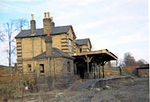Hill House, Saffron Walden
19th-century architecture in the United KingdomGrade II listed buildings in EssexHouses completed in the 19th centurySaffron Walden

Hill House is a 19th-century building at 75 High Street, Saffron Walden, Essex, England. It is listed Grade II. In 1845, George Stacey Gibson (1818–1883) and his wife Elizabeth, the daughter of Samuel Tuke, bought Hill House and lived there until their death. Gibson was a British banker, botanist and philanthropist.Their only child, Mary Wyatt Gibson (1855–1934) lived at Hill House until her death. After her death, most of the grounds of Hill House were developed for housing, and the family name lives on in Gibson Gardens, Gibson Way and Gibson Close.The building was listed in 1972 and is now divided into 17 flats.
Excerpt from the Wikipedia article Hill House, Saffron Walden (License: CC BY-SA 3.0, Authors, Images).Hill House, Saffron Walden
High Street, Uttlesford Pleasant Valley
Geographical coordinates (GPS) Address Phone number Nearby Places Show on map
Geographical coordinates (GPS)
| Latitude | Longitude |
|---|---|
| N 52.02097 ° | E 0.2395 ° |
Address
High Street
CB10 1AB Uttlesford, Pleasant Valley
England, United Kingdom
Open on Google Maps










